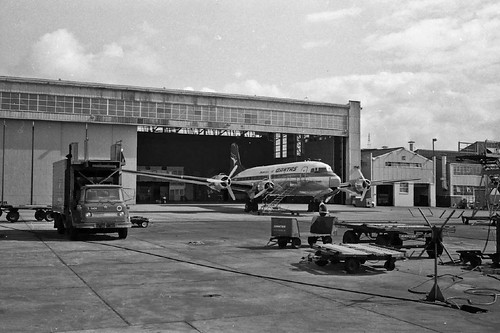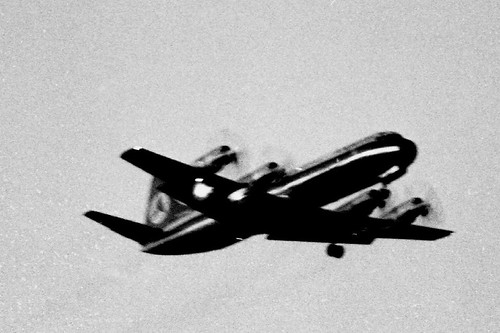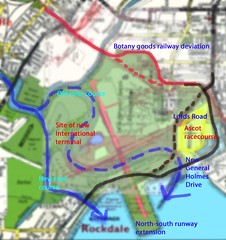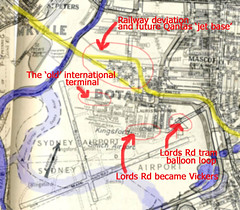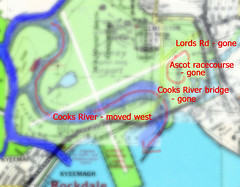Badgery's Creek. Western Sydney Airport. Or whatever it will be called. Well it's not "new" at all, it's not the first nor the only airport (or perhaps "airstrip") in the immediate area. But if built it will be the biggest. And it is another regular public transport (RPT) airport for Sydney with full allowance for both international and domestic services as well as future capacity increases.
Badgery's (let's call it WSA) in a nutshell:
- It's big, bigger than Sydney (let's call it KSA for "Kingsford-Smith Airport")
- It won't start as big as you probably imagine
- It won't open until at least 2025
- It isn't guaranteed to succeed, or grow, but probably will
- Runway alignment, operational "mode" and noise footprints aren't a done deal and...
- The last EIS we have (courtesy Blacktown City Council) is huge, impressive, and out of date.
A "Western Sydney Airport"? It's not a new idea, being one of several seemingly endless options explored since the end of WWII. It is the one that has been chosen, though. Not that being chosen means much. Badgery's Creek was first "chosen" in 1986. Given the politics played out already, it conceivably may still not go ahead at all. It's not planned to be open for business until 2025, after all.
Badgery's Creek - or Western Sydney Airport (WSA) - is on the lower-centre-left of this Google Map image, Sydney (KSA) on the lower-right. Depending on how you measure it, you are looking at 40 to 50kms between them. Fancy paying for a taxi cab?
Do we need it? The existing Sydney Airport can arguably handle more passengers and aircraft movements, by some accounts to 2025, by others (notably SACL, the airport owners) to 2045. Indeed aircraft movements are constrained more by legislation than by actual capacity. Whilst the legislation is there to protect residents from excessive noise, cold-hearted rationalists could observe that the cost of these restrictions to our community overall is too great. By allowing more flights in a greater spread of the day and night, or by shifting regional and/or freight traffic to existing alternatives such as Bankstown, Richmond and Camden, the "need" for a 2nd major RPT airport in Sydney is removed or at worst pushed further into the future.
Could the money - some $2.4 billion for the airport infrastructure and perhaps $4 billion more for land transport - be better spent elsewhere? Investment of any sort has a varying multiplier effect on the economy and finding the investment sweet spot - the best return - matters. You don't just throw cash away and hope for the best, after all. Mind you, the stakes are high. It is a big investment that impacts the region - and the nation - socially and politically. It will create local jobs - airports do that - and maybe pull some jobs away from the existing Sydney Airport. It opens up regional development more broadly, increases land value and creates opportunity. Of course such opportunities divert us from other possibilites, too. Perhaps better ones. And when land use changes the door opens to the speculators and developers. All well and good, as long as it's transparent and fair, especially to the current owners and residents.
Will it get built, and will it get used? Will the airlines use it? Only if they have to, I suspect. Do existing airline operators really want an alternative Sydney operation, another terminal, more staff on the ground and the extra complication of airport transfers? If you thought it was a hassle getting from the "domestic" side of KSA to the "international", imagine what it will be like if your connecting flight is at another airport some 40 or 50 kilometres away. Hail that taxi!
Existing airline operators may well hesitate; but some - perhaps those without an existing foothold at KSA - may actually want to claim Western Sydney as their own. Perhaps entirely new airlines will want "in". But which ones? Freight? Regional? Low-cost domestic inter-city? International?
Will the existing Sydney airport operators, SACL accept the competition without fuss, or indeed take up their first refusal rights? As far as I know they are still in "discussion". I'm sure they'd like to lock up the whole Sydney market, if only to protect their key asset - KSA.
What about the politics? Frankly, I don't think the political will is strong enough - or the election cycle long enough - to get this one off the ground as intended. With every change of government the policy shifts. In brief we have swayed from "let's do it" to "hang on, let's invest further at KSA" to "let's start small with a GA airport" and back to "no, let's do it"... peppered with the odd "how about we choose a new site?".
Yes, something will get built - if real spade work actually starts in 2016. It may only be a hole in the ground, though, if even that hole gets approved. Badgery's looks and sounds too good, especially when the media spin amps up the positives for the economy of Sydney's west, to just vanish completely. It's dangling there with a lot of other investment: new roads (big orbital ones, too); new rail (well maybe, if all comes to pass); new jobs (certainly in the construction phase and probably later as well). And so on. A lot of people want a slice of this "action".
But who knows exactly when or even if? What about upcoming State and Federal elections? Will the commitment remain, irrespective of result? What if the roads are built but no airport? What if the airport is scaled back in scope? What if it is built but just isn't used? What if it's just a sly way to shift some noise and aviation fuel from the east out west?
Still, let's not be negative. On paper it looks attractive. If it helps build value and jobs in western Sydney, good. If it takes some noise burden away from the current KSA footprint, great. So let's assume that somehow, something good will eventuate.
So what's next? OK, we have a site decision. Sure. We had that exact same decision perhaps 28-odd years ago (Hawke/Keating), except for the subsequent reversal (Howard/Costello), procrastination (everyone) and political second-guessing ever since. But now PM Abbott says "yes". Whilst a split Labor Party says "no", probably, most likely.
Assuming PM Abbott doesn't pull the pin, from here we have further planning and design work to be done. Negotiations with all affected parties. Plus renewed noise and other environmental impact assessments to be done. There's an endangered environment on the site and threatened species to be protected, too. Both the known and the as-yet unknown problems will need to be resolved in order to get traction. Perhaps more land will be required as well. It all takes time. Delays abound. Keep 2025 in mind. It may slip. Probably will.
Location map from the Draft 1997 EIS.
What does experience tell us? As a personal learning note here, let me say that I grew up under the 16 approach at Sydney (Kingsford-Smith) Airport. It wasn't the main runway for most of my early years but it was extended and extended and even duplicated until it became the focus for most of Sydney Airport's air traffic. Interestingly whilst the noise levels and frequency of movements increased substantially over many years, they also fell at times. It wasn't a given that things just got worse.
I won't say that it wasn't unsufferably noisy at times, it was, but I have to admit that 3 things in particular happened: firstly, aircraft engines became measurably quieter; secondly, those engines grew more powerful; and thirdly, on average, aircraft grew much, much larger.
Another thought here is that the flight paths changed over time. Especially so for inbound traffic. Different aircraft with different performance characteristics, coupled with evolving air trafic control procedures and technology meant changes to the areas affected by aircraft noise.
Having said that, what I would suggest now is that aircraft will probably not grow much larger than they are currently. I could be wrong of course but a triple decker seems unlikely. Still, it's possible. There may even be demand for such an unwieldy beast. It's also conceivable that airliners could grow further in length; but you get into all sorts of engineering limits as such elongated designs must rotate to lift off, without tail strike. And loading weights per tyre and wheel combination are a factor, too, both in engineering the aircraft and the concrete it lands or stands upon. New configurations, even twin-fuselage designs, can't be ruled out, of course. But whilst we must consider all of this in our airport design, it remains highly speculative. The problem is, should we guess wrongly with placement and design it's expensive to fix.
Whatever else happens with aircraft engineering, I would expect the noise to continue to fall, if only slightly, and for aircraft engine performance to continue to improve. In this way the noise footprint will continue to shrink, particularly for departures (which require full throttle and "max noise", generally). And with better design and a bigger performance envelope comes the possibility of "sharing" the impact more widely. In theory.
However the other lesson here is that successful airports attract people. If successful, it will get hemmed in by developments. But we all know this. So land will be reserved for "noise mitigation" reasons. And land will be reserved for runway duplication, too. Duplication that will inevitably widen the noise footprint. Just watch as history repeats itself.
At this stage, though, all we can do is "trust" that the currently empowered authorities will do as they say. So what are the plans, as we know them? (Knowing also that they will be changed: what we don't know is by how much.)
Runway alignment. A big question mark here. Given the orientation of the land already purchased, plus the prevailing winds and topography, a north-east by south-west alignment is probably what's on offer. Whilst an additional crosswind runway would aid smaller aircraft operations, particularly in the strong westerly to nor-westerly winds likely from August through to the end of summer, there's no hint as yet of extra land resumption. A shorter crosswnd runway would fit, just. Nevertheless unless it downscales to a GA airport (to ease Bankstown's load, for example) I think a crosswind runway is unlikely, at least at the possible 2025 opening date.
Generic master plan, from the Draft EIS again. Take it with a grain of salt, of course. Tilt it towards the north-east and it's your guess which parallel runway gets built first. Toss a coin with the shorter crosswind strip, too. If more length is added to the cross-strip (or a parallel one built) or more noise abatement required then more land will need to be acquired.
Noise Footprint. Yes, people do live in the area, but far fewer than live around Sydney's current major airport. And the denser population centres are much more distant from the proposed runways than the existing high density population that surrounds all but the Botany Bay-facing runways. WSA is surrounded by paddocks, mostly. Yes, Sydney does have the benefit of Botany Bay, true. But not all traffic can come and go over the water.
That's the good news: "It's not as bad as KSA". Catchy slogan, yes?
Once runway alignment is agreed, which looks decidely NE-SW at this stage, integration with existing flightpaths and other airspace restrictions will have a bearing on which areas are directly under the footprint.
Bear in mind (a) most likely just one runway will be built in the first phase; (b) upon reaching a safe altitude aircraft will most likely turn either left or right after takeoff, depending upon destination and designated standard departure procedures; and (c) approaches will similarly include standard corridors to the left or right of the field as well as to the north and south, allowing safe traffic separation. Altitude and throttle settings are important factors in noise mitigation of course and it is likely that specific noise-limiting procedures would be implemented over residential or other sensitive areas.
The indicative Cox Richardson graphic above shows the standard ANEF noise footprint of the assumed runway alignment overlaid on land use. Most of the affected area has already been rezoned industrial or contains low-density residential, however the underlying assumption is for sound-proofing of affected residences as well. The areas of highest impact are relatively distant from the twin parallel runways shown, certainly so in comparison with existing impact at KSA. Nevertheless when the final alignment and flightpaths are agreed and real-world noise measurement testing is undertaken it's likely that noise-related resumptions would be considered.
So, again, get out your grain of salt and ponder the following...
Above, that's the indicative flight path for option A, airport operation mode 1 from the '97 EIS. Don't get scared. Nothing's decided and the assumptions are both many and largely out of date. Read the full EIS or just take my word for it: it will change. Nevertheless it gives you an idea what approaches from the south west and departures to the north east may look like. But the final runway alignment? Who knows.
Again, to be taken with a grain of salt: from the '97 EIS showing approaches from the north east and departures to the south west.
Note that the airspace over Warragamba will be overflown only at considerable altitude, as will other water catchment areas towards the Illawarra. The '97 EIS certainly assumes that Warragamba airpsace will be used; and I do agree that it makes sense from a noise abatement perspective; however it may raise public debate over water quality and world heritage issues. It shouldn't be an issue as jet aircraft exhaust is "relatively" hot and clean, especially in comparison with internal combustion engines, and modern aircraft climb quickly. Yes, jet fuel - essentially kerosene - differs chemically from unleaded petrol, but studies have shown that aircraft exhaust "mixes" readily and disperses quickly over a wide area, whereas land-borne transportation typically disperses more slowly and creates more readily identifiable particulate deposit zones. Or to put it more clearly, you'd be far worse off beside a main road.
It's unavoidable that areas to the immediate north-east and south-west of the runway(s) will be "in" the affected zones, unless of course in the passage of time the runways are turned 180 degrees. OK, that seems unlikely, but let's not forget that runway alignment is not locked in. The '97 EIS dealt with 3 primary options plus different airport operational modes, and it's worth remembering that anything could change. Nevertheless here is another pretty illustration for you...
Harking back to that Cox-Richardson landuse overlay, this image (above) is the suggested N70 noise contour for Option A, mode 1, from the '97 EIS (N70 being a different methodology from the ANEF standard). The underlying assumptions include runway heading (not locked in), 30 million passengers a year (not really likely, at least from day 1) and a fully loaded 747-300 (not going to happen so much in 2025, it'll hopefully be a mix of newer aircraft).
You need to read and interpret the full EIS in context but if I dared summarise this, if you were living inside the red line you'd have a real problem; if you lived within the orange loop you'd still be upset about it; and the further out you go the less of a nuisance the noise may be. You may still be interrupted in conversation, and you may get disturbed at night. It will be an individual response. It will still matter to you, depending upon the situation. Schools and hospitals are individual cases where it may matter more. It all depends.
And here (above, same source) is option C, similar assumptions (but with the crosswind runway, used sparingly). Look what happens when you rotate the runways towards north. All of what I have written already applies here - don't panic, don't assume the worst. If a runway points directly at you then yes, it's likely that you'll get some aircraft noise. But departing aircraft gain altitude, may throttle back and generally turn towards their destination; which all means that the noise diminishes from point of take off. And arriving aircraft are of course throttled back, join the approach at different points, and are at a greater altitude when at a greater distance from touch down.
They do, however, make a lot of noise and vibration when using reverse thrust, but even this is mitigated by long runways and taxiways designed for faster exits. All of that aside, it's not precise, and it's full of out of date assumptions; but it does give you a rough idea, though.
World Heritage areas will likely also be "out", as will the rising land to the west, except, again, at altitude, and in a designated corridor.
Military airspace too will be "out"; so dodging around Richmond and Holsworthy will be a given, although again the airspace restrictions are governed by altitude (ie there is an upper cap to the restricted military airspace, allowing overflights).
But - like I've said - we don't know for sure about any of this - yet.
Bear in mind too that whilst aviation noise is unique in character it is not alone in affecting quality of life. Road and rail noise impact is real as well. And I haven't even touched on that. And I haven't mentioned air pollution either (it'll probably improve to the east of the field and worsen to the west); or even "odour". Yes, people complain about KSA's smell, although how they can tell it's an airport smell from 10km or more away is beyond me. Personally I can recognise that 'aviation kerosene' smell only up to about 5km away... anyway, it's all in the '97 EIS.
It gets complicated. It's not just noise mitigation that needs to be catered for. Of course you need to separate air traffic safely, too; so the airspace around Sydney, Bankstown and Camden airports will need to be accommodated; as will Albion Park, Wedderburn, Wilton, Warnervale and The Oaks airfields, too. Mixed air traffic would approach and depart these airports via defined corridors, in some cases by special exemption from otherwise strictly controlled airspace, or by curtailed control zones for individual airports. This is done now to separate Bankstown's general aviation traffic from Sydney's control whilst allowing such mixed traffic to flow freely. Of course "layers" of traffic will be separated by altitude, too, as they are now.
It can be done, it's not rocket science - especially when you realise that the aviation world operates in an environment based on airspace stacks, separated not just horizontally but vertically as well.
And in the end all things are possible if enough money is thrown at the problem. If the preferred solution is closure of one or more airports (or conflicting runways) then - presumably - compensation would be required.
Transport integration. A big one. Improved roads and (perhaps) heavy rail are planned but it's roads first (for now). Whilst roads are important, it's worth noting that over-encouragement of private motor vehicle use increases demand for car parking, including "drop off" zones, and may lead to road congestion and capacity "pinch points". Sydney Airport's Domestic terminals are, for example, constrained by the capacity of the loop road that feeds the terminals. Whilst suitable shuttle buses on appropriate routes will ease those problems, light or heavy rail options appear preferable to many. Shuttle buses, after all, are also "traffic".
If the Very Fast Train (VFT - or High Speed Rail) is a goer (and not a white elephant in disguise) then will it run via Sydney Airport or via Badgery's Creek? Neither? Or both? What about compensation for the "losers" in each scenario? Indeed the VFT represents competition for commercial aviation and may seek to navigate between the airports, even if the public good appears to favour connectivity rather than separation. There are huge arguments yet to come.
At least there's the semblance of a NSW Government plan with heavy rail extensions and reservations to service Badgery's. All drawn on a nice chart.
Of course this is all very orbital and north-south, although clearly both the SW and NW rail links eventually head into Sydney or Parramatta or both; and the SW link will get you to the current Sydney Airport if all of the planned connections are put in place. But until that's all done it's the road network that will ferry passengers between the airports, if that's what they want to do. (And if your connection is at the other airport, that's what you'll need to do.)
But with a "roads first" policy in action currently the likelihood is for multiple shuttle bus routes from Badgery's Creek to nearby heavy rail stations, to Parramatta CBD and on to Sydney Airport itself. For now, anyway. Or catch a taxi, of course.
Further land acquisition? The Ernst and Young Economic and Social Impact report (2012) suggested that "the latest footprint of the site will still require additional property (30 lots) to be compulsorily acquired at the southern end of the site. In line with Australian health and safety standards for noise pollution, properties located within Australian Noise Exposure Concept (ANEC) contours 40, 35 and 30 should be acquired by the Commonwealth Government. The analysis undertaken by WorleyParsons found that there could be up to a further 62 allotments that should be considered for compulsory acquisition as a result of noise impacts from the airport".
I doubt that a crosswind runway would eventuate, however if it did it would be constrained within the current site to well under 3000m. If proceeded with, further land acquisitions to the east and/or west may have to be considered. It would be for regional or smaller aircraft, generally, or larger aircraft landings.
Other risk factors. Much (if not all) of the reasoning behind a Western Sydney Airport is predicated on continuing - and expanding - demand for air travel. Underpinning that demand is the rate of world and local economic growth, which is currently subdued by many factors. One big factor is predicted global climate change. If current climate trends continue (as seems likely) then an increasing amount of world economic activity will focus on renewable energy provision and alternative, low-energy transport systems. How aviation - as a high-energy activity, especially on take-off - fits into that scenario is moot. It is likely that commercial aviation will face stiffer competition from alternatives such as high speed rail (HSR) over time. Whilst there are currently no HSR projects underway in Australia there is a groundswell of opinion in favour of it. Such projects would have obvious impact on both major regular public transport (RPT) airports, Sydney and Western Sydney. It is also worth noting that Sydney Airport faces the allied and perhaps more pressing impact of rising sea levels, which ultimately could strongly favour Western Sydney Airport's cost competitiveness.
If world action on climate change continues to grow then the possibility exists for commercial aviation to be identified more negatively and government action taken to dampen demand. This could be by direct-cost imposition of levies or taxes. The least impactful (whilst still effective) method would be via an emissions trading scheme (ETS). Many countries are indeed taking the latter approach. Ironically, of course, Australia has reversed its tactics in this regard, repealing the carbon tax, the precursor to an intended ETS.
So what is likely to change? Everything. The expense is huge and variable, both in dollar terms and the human and environmental cost. The pay-off is big but less certain; but to not act - after decades of indecision - risks hitting some sort of capacity limit with current aviation infrastructure. It's a gamble either way. More to come, I'm sure!
Oh, and someone seems to have their own airport design already in place on the Badgery's site (via Google).
At the end of the day you may weigh it all up - the noise, the traffic, the polution - and think it's a good idea overall. It saves driving to KSA when you need to get to the airport. And you may even get a better paid job out of it. Or maybe you'd just prefer a High Speed Train instead. It's your vote, and I suspect the whole issue will crop up at elections, State and Federal, more than a few times before we reach 2025.
More reading (some key sources):
Blacktown City Council - Draft EIS from 1997
Aboriginal heritage study - Draft EIS
Infrastructure and Transport - Joint Study on Aviation Capacity Sydney Region 2012
Infrastructure and Transport - Ernst and Young report on Economic and Social impact of airports 2012
Transport for NSW - consultation, SW Rail link extension
Bob Meyer, Cox Richardson presentation (including transport, land use and ANEF charts)
Sydney Airport's long term operating plan, including noise mitigation
Infrastructure and Regional development - High Speed Rail Studies
International Transport Forum on expanding airport capacity
An interesting timeline on Sydney's airport planning.
NSW Business Chamber - economic impact of a Western Sydney Airport
James Badgery - was into the ponies.
And for your amusement and edification, how about this impressively obsessive Condell Park site seemingly dedicated to defending the Bankstown community against any expansion of their local General Aviation airport. The detail is amazing (although sometimes colourful, incomplete, out of date and always biased) and they have done a lot of research, especially on runway length. Bankstown, of course, was once paddocks and no-one really complained about its wartime use by a variety of forces (who would dare, of course). But post-war many people (including an aunt and uncle of mine) moved in and hemmed the airport in from several sides - but especially from the eastern, runway-facing Condell Park side - and to the north. It's no one person's fault but it's a classic tale of airports attracting jobs, people and their houses.
Or check out my ever-growing list of Sydney's past and present airfields and airports.
















